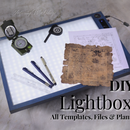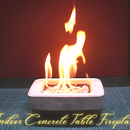Introduction: 3d Mount Everest Terrain With Recycled Papers
Hello everyone.... As I said earlier... I'm a student of Geography... And I'm a great fan of topographical features on the Earth surface... Also I'm a a tech enthusiast... And a nature lover.. So in this project in going to combine my these 3 aspects of life in a project...
In this project in going to discuss the process of recycling old papers and turning them into 3d terrains/maps...
Also with this method you can make replica of almost any surface on earth or objects... Because I have used 3d printed moulds for making these pieces...
So without further a do.. Let's gets started....
Step 1: Things We Are Going to Need
For making this beautiful project... We are going to need these following tools and equipments...
- A computer (mine is running on pentium 3240G...4gb ddr3 ram)
- Blender 2.9
- GIS plug in for blender
- Fusion 360
- Cura or pruca slicer
- 3d printer
- PLA filaments
- A small tub
- Old papers.
- A mixer/blender
- Craft glue
- Clamps
- Paint
- Some random tools
These are the basic required items to complete this project...
Step 2: Choosing the Desired Location on Earth
This is one of the most important step of this project... Choosing the desired Topographical location for the project... I always wanted to have a miniature Himalaya terrain... So I decided to use Mount Everest as my model...
You can use almost any surface on earth for this project... But I will suggest to take something high so that the layers can be prominent...
I took the mount everest in the center and some other parts of that region for my project...
Step 3: Adding the GIS Plug in In Blender 2.9
For making the 3d model of the mountain use the GIS plug-in for blender 2.9...the process of which is just selecting the desired location on Earth... Then fetching the elevation data from NASA and Google Inventory...
For the whole process in depth (I'm not qualified to teach the process)... Pls follow this awesome tutorial of CG Geek on Youtube...
After importing the files and making the 3d model... Reduce the number of nodes count with reduce modifier...
Export the whole model as an STL file...
Step 4: Making the 3 Piece Mold in Fusion 360...
Import the STL file in Fusion 360 and rescale it accordingly your preferred size... After doing so... It's time to make the mold...
Firstly repair the mesh object (wrap option is better... I did that one)
Convert the mesh object in to an solid object.. Cut the desired amount of area to be used as the model...
Extrude the borders using the sketch function...
Make a base with the features and locking system... Subdivide the 3d model from the base
Make a body and the pressing tool...
For better understanding the process... Use my files as example... Also you can watch *this* video on youtube...
After the mold is ready... Export it as 3MF file and it's ready for slicing...
Step 5: Slicing the Files in Cura and Exporting Gcode
Import the 3MF files in Cura or pruca slicer...
These are my settings for the parts...
- 0.28 mm later hight
- 35% gyroid infill
- 4 bottom layers and 5 top layers
- Ironing enabled
- Wall count - 5
- Wall optimization - turned on
Export the Gcode files to a sd card for printing
Step 6: Preparing the Old Papers
I was collecting old papers for quite some times... Which includes old used A4 papers,, rough papers etc..
For this project. The first thing to done is to carefully remove al the staples(metal) and platic pieces from the pages(if any).... Don't miss any one... Because that will be devastating while making the pulp...
Now take a small tub with some water (you may use some Luke warm water)... Soak the papers completely in the water and let it soak for at least 2 hours... If you have thick papers... You may increase the soaking time period...
Step 7: Making Paper Pulp
For making the pulp... It's just the process of taking the soaked papers and grinding the to a fine consistency...
I used the mixer from our kitchen with a a jar which we don't use for cooking...
Pls make sure to ask you mother before doing this... Otherwise... I don't know what Will happen 😂..
Take small amount of paper at a time... With some water and grind for 30 seconds.... If not done.. Run for some more time.. With regular intervals... Don't over heat the machine...
After the whole batch is done... Strain the most of the water using a fine synthetic cloth...
Step 8: Processing the Paper Pulp
For processing the paper pulp... Get some pva or craft glue... And mix with the paper pulp...
Mix well... If needed use some more glue...
The mixture should have a clay like consistency...
Step 9: Filling the Mold and Pressing...
Attach the mold base with the body... And if you have.. Use some mold release...
Put some paper mashe in the mold.. And press against the small details of the mountains and the border area...
Use something flat to apply pressure on the paper mashe...
Keep adding more paper mixture and keep pressing them... Try to make a compact filling...
After the mold is filled to the top... Press the cover... And squeeze them shut...
Use two sheets of plastic or hard wood/cardboard... Or something flat to evenly distribute the press2from the Clamps..
I used 4 Clamps for the pressing part... Don't squeeze too much at once... It might result breaking the mold... Let the water come out slowly... Then increase the pressure.. Take your time and do this in small steps...
After the mold is pressed totally... Let the mold rest for atleast 24 hours... Before opening the mold...
Step 10: Removing the Part From Molds..
After 24 hours... Remove the pressing piece/cover.... From the mold... And check if the piece is molded properly.. If not... You can either take out all the mashe and use some more glue.. Or press again...
However if the pressing process is done correctly... The piece should be fine...
Now let the piece dry for 2 days in open air... The water has to evaporate before the final removal from the mold...
After 2 days... Carefully remove the part from the mold and let it dry a bit further...
Step 11: Colour the Model...
Now it's an optional step.. You can either leave the piece as it is without any colour... Or you can use reference pictures from the satellite image from Google maps.. And can colour the areas...
I will suggest to keep the colour thin... Otherwise the contours created by the layer lines will be less visible...
I painted my Everest model with the actual colours of the area... And I'm quite satisfied...
Step 12: It's Done...
And it's done.. That was the process of reusing old papers and turning them into 3d terrain models... With the help of 3d printed molds...
The most beautiful part of this project is this method can be used for making other things... Or other terrains on earth... Also.. You can reuse the pressing and the body of the mold for other projects... You just have to print the base parts...
Whatever... Thanks for having a look at my one of the favorite projects... If you have any doubts or suggestions.. Or even any criticism... Pls let me know in the comments down bellow... I will always love to see them...
Have a nice day 😄 😄 😄
**Follow Infinity Workshop
Facebook: https://www.facebook.com/InfinityWork...
Twitter: https://www.facebook.com/InfinityWork...
Pinterest: https://in.pinterest.com/infinitywork...
Instagram : https://www.instagram.com/infinity_wo...
Instructables: https://www.instructables.com/member/...
Youtube: https://www.youtube.com/c/InfinityWorkshop
Consider supporting my channel by giving like, share, comment & Subscribing #Infinity_Workshop Thanks for supporting...

Second Prize in the
Paper Challenge













